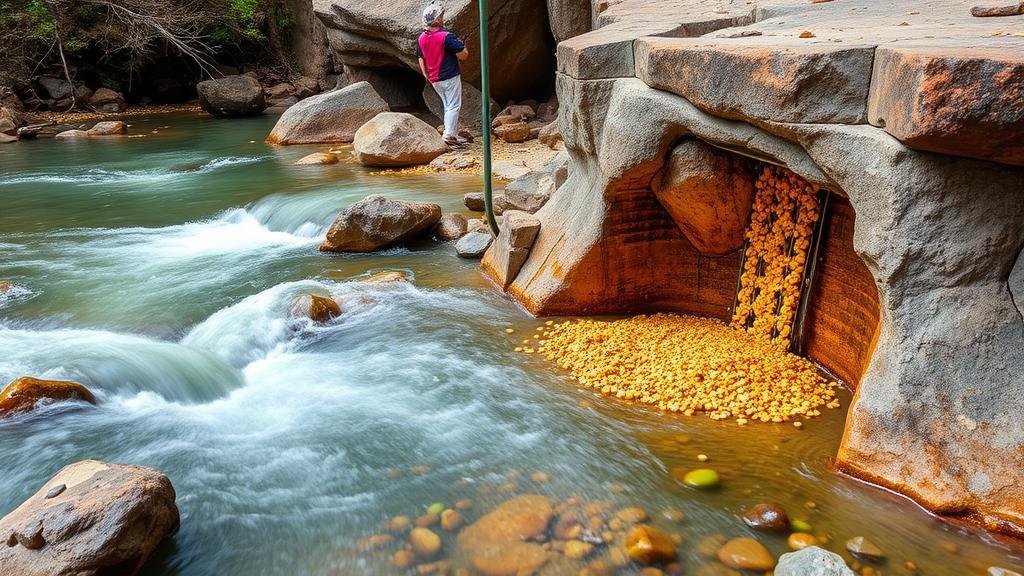Spotting Natural Rock Dams That Trap Heavy Gold Particles in Streams
Spotting Natural Rock Dams That Trap Heavy Gold Particles in Streams
For gold prospectors and enthusiasts, understanding how to locate natural rock dams that can trap heavy gold particles is crucial. These geological formations can significantly enhance the likelihood of finding gold nuggets and flakes in a streambed. This article provides a comprehensive guide to identifying these natural structures and explains why they are effective at capturing heavy metals.
Understanding Natural Rock Dams
Natural rock dams are formations created by boulders, logs, or other debris that obstruct the flow of a stream. When water encounters these obstacles, it slows down, causing sediment–including heavy minerals like gold–to settle out of suspension. This process is vital for prospectors, as it can lead to concentrated deposits of gold downstream.
Why Gold Particles Get Trapped
Gold is significantly denser than most other materials found in riverbeds, such as silt and sand. This density allows gold particles to settle when water flows slow down, making natural rock dams effective traps. following factors contribute to the trapping process:
- Water Velocity: Slower water currents allow heavier particles to drop out of the flow.
- Streambed Topography: Variations in the streambed create areas of low pressure where sediments can accumulate.
- Material Composition: The nature and arrangement of rocks and debris can create pockets that enhance trapping efficiency.
Identifying Natural Rock Dams
Finding natural rock dams involves observing the landscape and stream dynamics. Here are some tips on how to identify them effectively:
- Look for Obstructions: Examine the stream for boulders or fallen trees that disrupt the flow.
- Examine Sediment Patterns: Observe areas where sediment is visibly accumulating; these often indicate upstream obstruction.
- Analyze Water Flow: Use a simple float method–drop a small object into the water and observe how it moves. If it slows down significantly in some areas, you may be near a natural dam.
- Seasonal Changes: Pay attention to changes during low water levels or during heavy rains, as sediment accumulation patterns can shift.
Case Study: The Yukons Gold Streams
A compelling case study can be observed in the rivers of the Yukon Territory, Canada, where miners historically have found significant amounts of gold. region is characterized by natural rock formations and is rich in both gold and other heavy minerals.
Notably, in the Klondike region, natural rock dams formed from glacial debris have served as effective traps. Miners in the past recognized the importance of these dams, leading them to strategically position their operations downstream. Studies indicate that areas within 100 feet of natural rock formations can yield gold concentrations that are 5-10 times higher than adjacent areas.
Challenges and Considerations
While natural rock dams provide excellent opportunities for gold prospecting, several challenges must be acknowledged:
- Environmental Impact: Disturbing natural ecosystems can lead to habitat destruction and erosion.
- Legal Regulations: Ensure compliance with local mining and prospecting laws to avoid fines or legal issues.
- Physical Risks: Navigating streambeds can be hazardous due to slippery rocks and fast-moving water.
Actionable Takeaways
For those interested in gold prospecting, here are actionable steps to spot and take advantage of natural rock dams:
- Equip yourself with proper tools like a gold pan, shovel, and safety gear.
- Research local geology to understand typical rock formations and stream patterns.
- Visit riverbanks during low water periods for better visibility of sediment patterns.
- Engage with local prospecting communities for shared knowledge and experience.
By understanding the dynamics of natural rock dams and employing the proper strategies for locating them, prospectors can increase their chances of uncovering significant gold deposits in streams.



